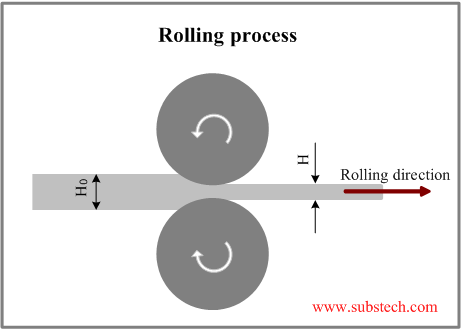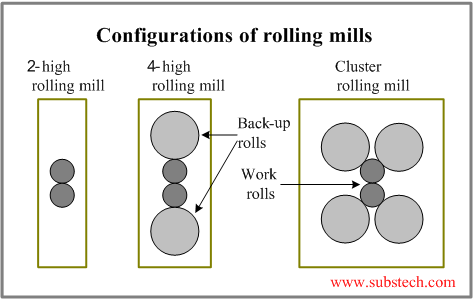Main page
About us
Sliding Bearings Consulting
Advertising Opportunities

to Metals
to Metal forming technologies
Rolling
Dr. Dmitri Kopeliovich
Rolling is a process of reduction of the cross-sectional area or shaping a metal piece through the deformation caused by a pair of rotating in opposite directions metal rolls.
A scheme of rolling process is shown in the picture:
The gap between the rotating rolls is less than the thickness of the entering bar H0 therefore a friction force is necessary in order to bite the bar and to pull it through the rolls.
A metal bar passing through the rotating rolls is squeezed, and it elongates while its cross section area decreases.
The amount of deformation “R” achieved in a flat rolling operation (thickness reduction) is determined by the relationship:
R = 100% * (H – H0)/H0
A machine used for rolling metal is called rolling mill.
A typical rolling mill consists of a pair of rolls driven by an electric motor transmitting a torque through a gear and pair of cardans. The rolls are equipped with bearings and mounted in a stand with a screw-down mechanism.
A force applied to the rolls in vertical direction is called roll separating force.
A rolling mill is characterized by the maximum values of its roll separating force and the torque.
The maximum amount of deformation (thickness reduction) which may be achieved in a single rolling pass is determined by the maximum roll separating force, maximum torque, work roll diameter, friction coefficient and mechanical strength of the rolled material and its width.
Low roll diameter results in low roll contact area and consequently in low absolute value of the roll separating force and the torque required for achieving a certain thickness reduction.
However such rolls are susceptible to bending and causing non-uniform widthwise strip thickness distribution (convex crown).
Complex rolling mill designs employing back-up rolls are used to diminish the bending effect:
Hot rolling is a rolling operation carried out at a temperature exceeding the recrystallization temperature and permitting large amount of deformation.
Cold rolling is a rolling operation carried out at room temperature. Cold rolling is commonly conducted after hot rolling when good surface quality and low thickness tolerance are needed. Cold rolling causes material strengthening and may be followed by annealing.
to top
Related internal links




